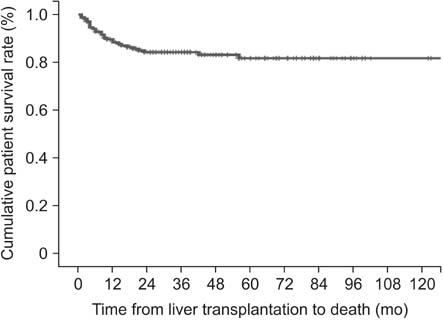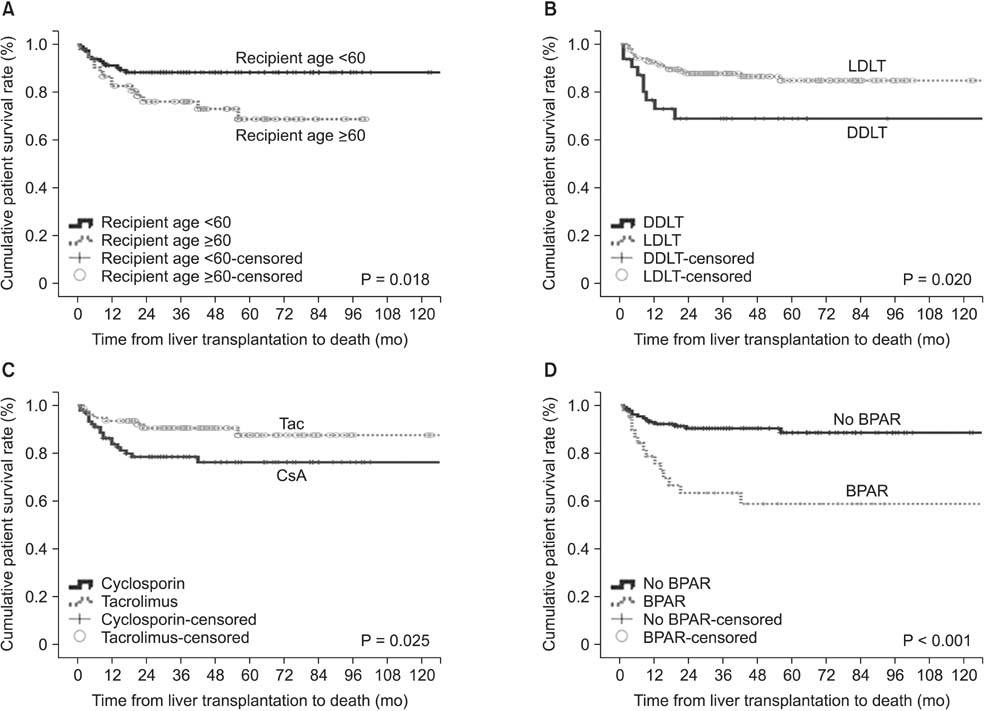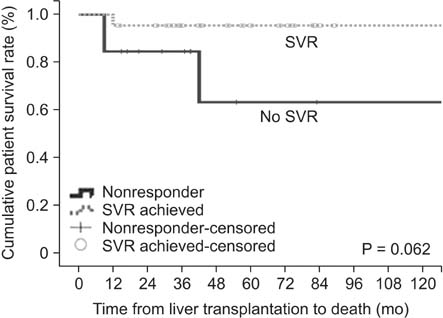Outcomes for patients with HCV after liver transplantation in Korea: a multicenter study
- Affiliations
-
- 1Department of Surgery, Samsung Medical Center, Sungkyunkwan University School of Medicine, Seoul, Korea.
- 2Department of Surgery, Seoul National University Hospital, Seoul National University College of Medicine, Seoul, Korea. kwleegs@gmail.com
- 3Division of Hepatobiliary Surgery and Liver Transplantation, Department of Surgery, Asan Medical Center, University of Ulsan College of Medicine, Seoul, Korea.
- 4Department of Surgery, Seoul Metropolitan Government-Seoul National University Boramae Medical Center, Seoul, Korea.
- KMID: 2149930
- DOI: http://doi.org/10.4174/astr.2016.90.1.36
Abstract
- PURPOSE
HCV-related liver disease is the most common indication for liver transplantation (LT) in Western countries, whereas HCV LT is rare in Korea. We conducted a survey of HCV RNA-positive patients who underwent LT and investigated the prognostic factors for patient survival and the effects of immunosuppression.
METHODS
We retrospectively reviewed the multicenter records of 192 HCV RNA-positive patients who underwent LT.
RESULTS
The 1-, 3-, and 5-year overall survival rates were 78.8%, 75.3%, and 73.1%, respectively. Excluding the cases of hospital mortality (n = 23), 169 patients were evaluated for patient survival. Most patients were genotype 1 (n = 111, 65.7%) or genotype 2 (n = 42, 24.9%). The proportion of living donors for LT (n = 135, 79.9%) was higher than that of deceased donors (deceased donor liver transplantation [DDLT], n = 34, 20.1%). The median donor and recipient ages were 32 years and 56 years, respectively. Twenty-eight patients (16.6%) died during the observation period. Seventy-five patients underwent universal prophylaxis and 15 received preemptive therapy. HCV recurrence was detected in 97 patients. Recipients who were older than 60, received DDLT, used cyclosporine, or suffered acute rejection had lower rates of survival.
CONCLUSION
Patent survival rates of HCV patients after LT in Korea were comparable with other countries.
MeSH Terms
Figure
Cited by 3 articles
-
Changes in the indications for living donor liver transplantation: single-institution experience of 3,145 cases over 10 years
Sang-Hyun Kang, Shin Hwang, Chul-Soo Ahn, Ki-Hun Kim, Deok-Bog Moon, Tae-Yong Ha, Gi-Won Song, Dong-Hwan Jung, Gil-Chun Park, Jung-Man Namgoong, Young-In Yoon, Hui-Dong Cho, Jae-Hyun Kwon, Yong-Kyu Chung, Jin-Uk Choi, Sung-Gyu Lee
Korean J Transplant. 2020;34(1):47-54. doi: 10.4285/kjt.2020.34.1.47.Use of direct antiviral agents in liver transplant recipients with hepatitis C virus in Korea: 2-center experience
Jong Man Kim, Kwang-Woong Lee, Dong-Hyun Sinn, Gyu-Seong Choi, Nam-Joon Yi, Choon Hyuck David Kwon, Kyung-Suk Suh, Jae-Won Joh
Ann Surg Treat Res. 2018;95(3):147-151. doi: 10.4174/astr.2018.95.3.147.Long-term outcomes after stent insertion in patients with early and late hepatic vein outflow obstruction after living donor liver transplantation
Kyeong Sik Kim, Ji Soo Lee, Gyu Sung Choi, Choon Hyuck David Kwon, Jae-Won Cho, Suk-Koo Lee, Kwang Bo Park, Sung Ki Cho, Sung Wook Shin, Jong Man Kim
Ann Surg Treat Res. 2018;95(6):333-339. doi: 10.4174/astr.2018.95.6.333.
Reference
-
1. Mohd Hanafiah K, Groeger J, Flaxman AD, Wiersma ST. Global epidemiology of hepatitis C virus infection: new estimates of age-specific antibody to HCV seroprevalence. Hepatology. 2013; 57:1333–1342.2. European Association for the Study of the Liver. EASL Clinical Practice Guidelines: management of hepatitis C virus infection. J Hepatol. 2011; 55:245–264.3. Shin HR, Hwang SY, Nam CM. The prevalence of hepatitis C virus infection in Korea: pooled analysis. J Korean Med Sci. 2005; 20:985–988.4. Kim SJ. Viral hepatitis surveillance system and statue of C hepatitis sentinel surveillance in Korea. Publ Health Wkly Rep. 2012; 5:214–219.5. Lee HW, Lee KW, Kim BW, Song GW, Han YS, Kwon CH, et al. Liver Transplantation for Hepatitis C Virus-Related Liver Disease in Korea. J Korean Soc Transplant. 2012; 26:269–276.6. Gane EJ, Naoumov NV, Qian KP, Mondelli MU, Maertens G, Portmann BC, et al. A longitudinal analysis of hepatitis C virus replication following liver transplantation. Gastroenterology. 1996; 110:167–177.7. Balagopal A, Thomas DL, Thio CL. IL28B and the control of hepatitis C virus infection. Gastroenterology. 2010; 139:1865–1876.8. Banff Working Group on Liver Allograft Pathology. Importance of liver biopsy findings in immunosuppression management: biopsy monitoring and working criteria for patients with operational tolerance. Liver Transpl. 2012; 18:1154–1170.9. Singal AK, Guturu P, Hmoud B, Kuo YF, Salameh H, Wiesner RH. Evolving frequency and outcomes of liver transplantation based on etiology of liver disease. Transplantation. 2013; 95:755–760.10. Adam R, Karam V, Delvart V, O'Grady J, Mirza D, Klempnauer J, et al. Evolution of indications and results of liver transplantation in Europe. A report from the European Liver Transplant Registry (ELTR). J Hepatol. 2012; 57:675–688.11. Akamatsu N, Sugawara Y, Kokudo N, Eguchi S, Fujiwara T, Ohdan H, et al. Outcomes of living donor liver transplantation for hepatitis C virus-positive recipients in Japan: results of a nationwide survey. Transpl Int. 2014; 27:767–774.12. Everson GT, Trotter J, Forman L, Kugelmas M, Halprin A, Fey B, et al. Treatment of advanced hepatitis C with a low accelerating dosage regimen of antiviral therapy. Hepatology. 2005; 42:255–262.13. Howell J, Angus P, Gow P. Hepatitis C recurrence: the Achilles heel of liver transplantation. Transpl Infect Dis. 2014; 16:1–16.14. Charlton M, Seaberg E, Wiesner R, Everhart J, Zetterman R, Lake J, et al. Predictors of patient and graft survival following liver transplantation for hepatitis C. Hepatology. 1998; 28:823–830.15. Shackel NA, Jamias J, Rahman W, Prakoso E, Strasser SI, Koorey DJ, et al. Early high peak hepatitis C viral load levels independently predict hepatitis C-related liver failure post-liver transplantation. Liver Transpl. 2009; 15:709–718.16. Roche B, Samuel D. Hepatitis C virus treatment pre- and post-liver transplantation. Liver Int. 2012; 32:Suppl 1. 120–128.17. Chalasani N, Manzarbeitia C, Ferenci P, Vogel W, Fontana RJ, Voigt M, et al. Peginterferon alfa-2a for hepatitis C after liver transplantation: two randomized, controlled trials. Hepatology. 2005; 41:289–298.18. Bzowej N, Nelson DR, Terrault NA, Everson GT, Teng LL, Prabhakar A, et al. PHOENIX: A randomized controlled trial of peginterferon alfa-2a plus ribavirin as a prophylactic treatment after liver transplantation for hepatitis C virus. Liver Transpl. 2011; 17:528–538.19. Guillouche P, Feray C. Systematic review: anti-viral therapy of recurrent hepatitis C after liver transplantation. Aliment Pharmacol Ther. 2011; 33:163–174.20. Berenguer M, Rayon JM, Prieto M, Aguilera V, Nicolas D, Ortiz V, et al. Are posttransplantation protocol liver biopsies useful in the long term? Liver Transpl. 2001; 7:790–796.21. Berenguer M, Palau A, Aguilera V, Rayon JM, Juan FS, Prieto M. Clinical benefits of antiviral therapy in patients with recurrent hepatitis C following liver transplantation. Am J Transplant. 2008; 8:679–687.22. Fukuhara T, Taketomi A, Motomura T, Okano S, Ninomiya A, Abe T, et al. Variants in IL28B in liver recipients and donors correlate with response to peg-interferon and ribavirin therapy for recurrent hepatitis C. Gastroenterology. 2010; 139:1577–1585. 1585.e1–1585.e3.
- Full Text Links
- Actions
-
Cited
- CITED
-
- Close
- Share
- Similar articles
-
- The Management of HCV Recurrence after Liver Transplantation
- Hepatitis C Viral Markers in the Recipients Before and After Kidney Transplantation
- Management of Hepatitis C Viral Infection Pre- and Post-liver Transplantation
- Outcomes for Patients with Hepatitis C Virus after Liver Transplantation in Korea
- Strategy for Hepatitis C Treatment in Liver Transplant Settings




